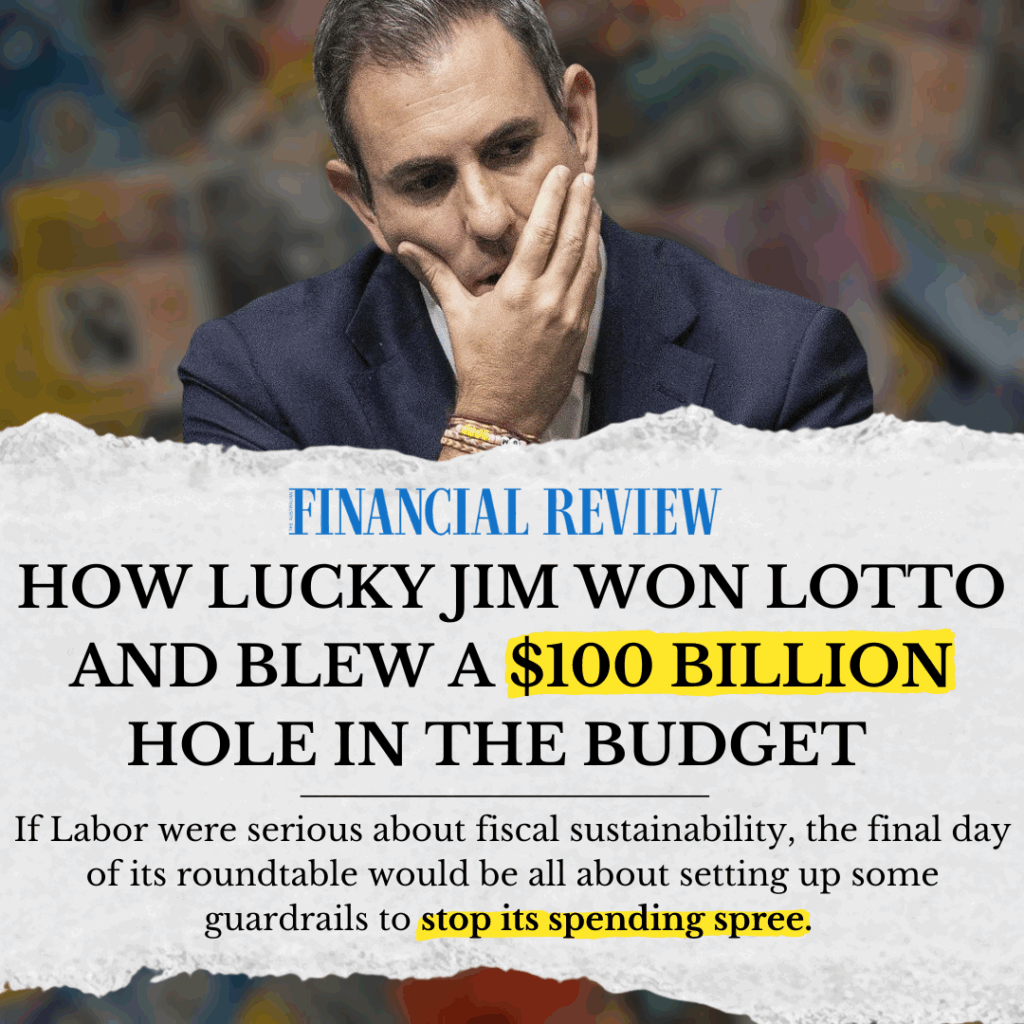I was pleased to see Treasurer Jim Chalmers finally admit soon after the election that his budget is not sustainable. Because it isn’t.
Like any process of economic reform, fixing the budget begins with defining the problem you are trying to solve. You’ll never come up with the right solution if you aren’t trying to solve the right problem.
For three years, the Treasurer has spun the line that the Albanese Government has made good progress on budget repair; that he’s gotten the budget into “better nick”.
This is utterly false, and the Treasurer’s own budget papers say so in black and white.
The truth is that this Treasurer has been the beneficiary of the largest budget windfall in history.
Crediting the Treasurer with this windfall is like crediting a punter for winning the lotto.
The Treasurer has enjoyed the highest terms of trade in Australia’s history, boosting the budget bottom line by $241 billion across four years.
Had the Treasurer simply sat on his hands and allowed this windfall to pay down debt, it would have fallen by $241 billion.
Yet a comparison of the 2022 and 2025 Pre-Election Economic and Fiscal Outlooks shows debt is only $147 billion lower than originally forecast.
So roughly $100 billion has gone missing. Where did it go?
A handy thing about the budget papers is that they separate improvements in the budget into things in the government’s control and things out of its control. They let you distinguish between the Treasurer’s hard work and his lotto winnings.
And the budget papers show that the Treasurer blew the $100 billion.
Around three quarters went to additional on-budget decisions and one quarter to higher off-budget spending.
All of it went onto the national credit card, leaving our kids and grandkids to pay it off.
It’s a lot of money to spend—more than what the Coalition’s Stage 3 tax cuts cost over an equivalent period.
Budgets are about choices. And this government chose to spend and tax you more.
While the Treasurer was on his spending spree over the last three years, Australian families found ways to live within their means to make ends meet.
This government is apparently above that.
Had the Treasurer demonstrated that same discipline and offset his new spending commitments by finding savings elsewhere, the national debt would be $100 billion lower today.
We’ve heard a lot about monetary policy frameworks in recent years, about the rules the RBA must abide by to control inflation.
But we’ve heard absolutely nothing from this government about fiscal policy frameworks, about the rules the Treasurer must abide by to control spending.
The Treasurer threw the Coalition’s fiscal rules out the window upon coming to office, and that’s when his spending spree began.
As former RBA Governor Philip Lowe said this week, “we haven’t really got back to a clearly articulated framework for decision-making with fiscal policy”.
“Those frameworks are really important in disciplining the political process. It seems to be where there is a need, we’ll spend,” he said.
Under Labor, government spending has exploded, from 24% to 27% of GDP—the highest level outside of recession since 1986. Spending today is $160 billion higher than in the last year under the Coalition—$16,000 for every household.
But, like magic, Labor forecasts this spending surge to stop this year, and then for spending to remain constant over the next decade.
The government assumes its NDIS growth targets are miraculously achieved, no more money for defence, and nothing for the Prime Minister’s plan for universal childcare.
All of a sudden, Labor will start offsetting all new spending—something it has never done at any time during its first three years, and all without any fiscal guardrails.
Even under this fantasy scenario, the government forecasts $1 trillion of debt this year and $1.2 trillion by the time of the next election, and 11 deficits in a row.
Its one and only policy for closing the deficit over the coming decade is to slap ordinary working people with higher income taxes.
Labor’s roundtable presupposes that we all support the government’s spending spree, so the focus is on how to raise more taxes to pay for it.
The Coalition rejects this premise.
The process of budget repair must start with spending restraint. The government’s budget, just like the family budget, is all about hard choices.
Everyday Australians can’t simply throw it all on the credit card—so neither should their government.
If the government were serious about fiscal sustainability, the final day of its roundtable today would be all about setting up some fiscal guardrails to stop its spending spree.
Then the Coalition would be more than happy to discuss tax reform that delivers lower, simpler and fairer taxes to the Australian people.
Ted O’Brien is the Deputy Opposition Leader and Shadow Treasurer
